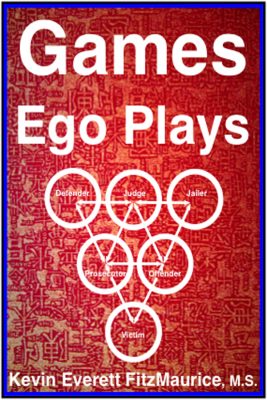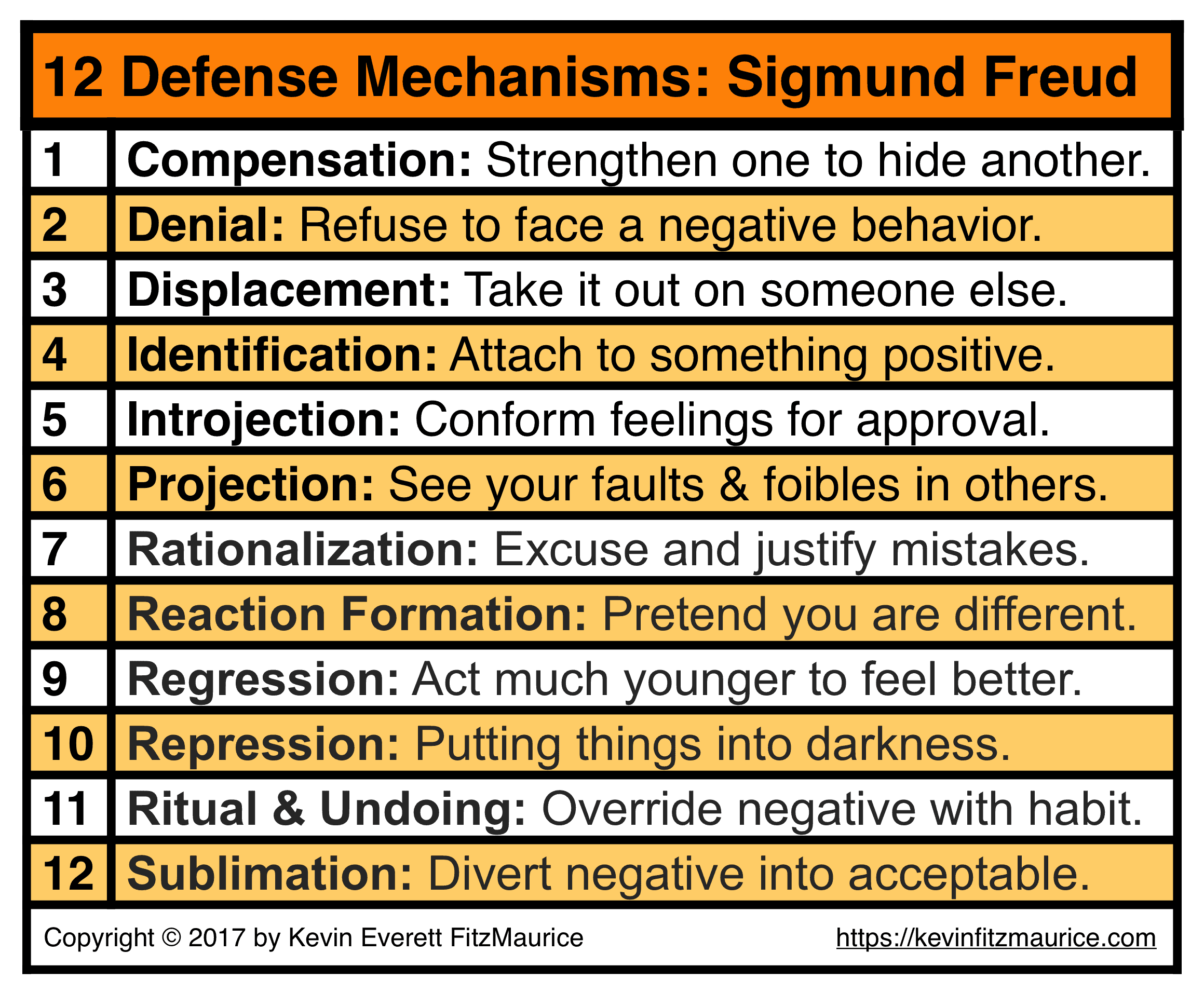Ego Defenses12 Defenses: List12 Defenses: TableExplanations of 12Alternate SystemRelated Information6 Groups of Topics10 Skills & Topics
Ego Defense Mechanisms & Self-Esteem Issues
- Ego will help you to recognize, remove, and replace your ego: a.k.a. self-esteem.
- The information on this page is now included in Journal Journey from Ego.
- Games Ego Plays diagrams and explains social interactions.
Freud Defense Mechanisms: Page about defense mechanisms working for self-esteem as an example of how the ego tries to control.
“The worse deceit is self-deceit.“ —David Ben-Gurion
“People have motives and thoughts of which they are not aware.“ —Albert Ellis
- Read and discover the best diagrams and maps of how people play games with your mind and heart.
Freud Defense Mechanisms: & Self-Esteem
- Sigmund Freud made some useful contributions to psychology, one of which is his list of common defense mechanisms.
- Freud never directly applied his defense mechanisms to self-esteem or ego; therefore, what follows is not to be considered to be endorsed by psychodynamic theories.
- Freud’s defense mechanisms will now be applied to pride, ego, and self-esteem.
- That is, Freud’s defense mechanisms will each be explained by how they serve to protect the ego from shame and ego pain.
- The 12 defense mechanisms are organized alphabetically.
Freud Defense Mechanisms: Listed by Name
- Compensation
- Denial
- Displacement
- Identification
- Introjection
- Projection
- Rationalization
- Reaction Formation
- Regression
- Repression
- Ritual and Undoing
- Sublimation
- Read and master the life skill of acceptance using the best combination of CBT, REBT, & Stoicism.
Freud Defense Mechanisms: 12
- Click for a page on 32 defense mechanisms.
- Read and master the life skill of acceptance using the best combination of CBT, REBT, & Stoicism.
Explanatory List of Freud’s 12 Defense Mechanisms
1. COMPENSATION
- Compensation is the process of masking perceived negative self-concepts by developing positive self-concepts to make up for and to cover those perceived negative self-concepts.
- For example, if you think you are an idiot, then you may work at becoming physically fitter than others to make up for this shortcoming by compensating for it in another area of human activity.
- The reasoning is that by having a good self-concept about being physically fit, you can then ignore, cover, or even negate your negative self-concept about your reasoning capability.
2. DENIAL
- Denial is the subconscious or conscious process of blinding yourself to negative self-concepts that you believe exist in you but that you do not want to deal with or face.
- It is “closing your eyes” to your negative self-concepts about people, places, or things that you find too severe to admit or deal with.
- For example, a family may pretend and act as if their father is only sick or having a hard time when it is evident to everyone that he is an abusive alcoholic.
- The negative self-concept for each family member comes from identifying with the father because he is a part of the family; the father cannot be viewed as a negative image, or everyone else in the family, too, will be considered to be that negative image.
3. DISPLACEMENT
- Displacement is when you express feelings to a substitute target because you are unwilling to express them to the real target.
- The feelings expressed to the substitute target are based on your negative self-concepts about the real target and yourself in relation to the real target. That is, you think poorly of someone and yourself in relation to them.
- “Crooked anger” or “dumping” on another are examples of displacement. In such examples, you let out your anger and frustration about the negative self-concepts you are feeling about someone else and yourself in relation to them onto a safer target.
- The safer target can be someone below you in rank or position, someone dependent upon you for financial support, or someone under your power and control.
- Generally, alternate targets are targets that cannot object or fight back as opposed to actual targets that might object and fight back.
- For example, the father comes home from work angry at his boss, so he verbally abuses his wife and children. This process is often seen in bureaucracies: abuse and blame are passed down the ladder.
4. IDENTIFICATION
- Identification as a defense mechanism is the identification of yourself with causes, groups, heroes, leaders, movie stars, organizations, religions, sports stars, or whatever you perceive as being good self-concepts or self-images.
- This identification is a way to think of yourself as having good self-concepts or images.
- For example, you may identify with a crusade to help hungry children so that you can incorporate into your ego some of the good self-images associated with that crusade.
- Worldwide sports prey upon this defense mechanism to make money.
- Countries also prey upon this defense mechanism to make war by using identification with the government to enlist cannon fodder, a.k.a. soldiers.
5. INTROJECTION
- Introjection is the acceptance of the standards of others to avoid being rated as having negative self-concepts by their standards. For example, you may uncritically accept the standards of your government or religion to be accepted as good self-concepts by them.
- Introjection can be considered as the extreme case of conformity because introjection involves conforming your beliefs, as well as your behaviors, to some authority (often as an ideal or high self-concept).
- So-called educational systems prey upon this defense mechanism to produce parrots to spread their dogmas as if they were factual and superior.
6. PROJECTION
- Projection is the attribution to others of your negative self-concepts. This projection occurs when you want to avoid facing negative self-concepts about your behaviors or intentions, and you do so by seeing them in other people instead.
- For example, you are mad at your spouse and subconsciously damning them, but you instead think or claim that they are mad at you and damning you in their mind.
- Alternatively, you may believe that you are inferior and therefore attack another race, ethnicity, or belief system, claiming it is inferior.
7. RATIONALIZATION
- Rationalization is the process of explaining why, this time, you do not have to be judged as having negative self-concepts because of your behaviors or intentions.
- That is, you justify and excuse your misdeeds or mistakes with reasons that are circumstantial at best and unfounded at worst.
- Rationalization is sometimes referred to as the “sour grapes” response when, for example, you rationalize that you do not want something that you did not get because “It was lousy, anyway.”
- Rationalization can also take the opposite tack or what is sometimes referred to as the “sweet lemon” response. In this case, you justify, for example, an error in purchasing by extolling some of the insignificant good points of the product.
- People commonly excuse their poor behavior as being due to poor circumstances but hold other people accountable for their poor behavior as being due to their poor character.
8. REACTION FORMATION
- Reaction formation is the process of developing conscious positive self-concepts to cover and hide opposite, negative self-concepts. It is the making up for negative self-concepts by showing off their reverse.
- For example, you may hate your parents, but instead of showing that, you go out of your way to show care and concern for them so that you can be judged to be a loving child.
- Another typical example is someone with a speech impediment going to school to become a public announcer to have themselves believe through others that they are a good speaker.
- Another example is the concrete thinker joining a group of abstract thinkers (for example, General Semantics) and pretending they understand the abstractions by memorizing and defending definitions held by the group.
9. REGRESSION
- Regression is returning to an earlier time in your life when you were not so threatened with becoming negative self-concepts. You return to thoughts, feelings, and behaviors of an earlier developmental stage to identify yourself as you used to back then.
- For example, you may be being criticized as an adult and feeling horrible about it.
- To escape this, you revert to acting like a little child because you did not then own criticism as defining you as having negative self-concepts because others mostly thought of you as good images back then.
10. REPRESSION
- Repression is the unconscious and seemingly involuntary removal from awareness of the negative self-concepts that your ego finds too painful to tolerate. For example, you may completely block out thoughts that you have of wanting to kill one of your parents.
- Repression is not the same as suppression, which is the conscious removal from the consciousness of intolerable negative self-concepts. Unconsciousness was Freud’s renaming of the spiritual concept of internal darkness.
- Repression is a choice, but a decision that we choose to remain unaware of as part of the defense of repression.
11. RITUAL AND UNDOING
- Ritual and undoing as a defense mechanism is the process of trying to undo negative self-concept ratings of yourself by performing rituals or behaviors designed to offset the behaviors that the negative evaluations of you were based on.
- For example, a millionaire might give to charities for the poor to make up for profiting from the poor. Alternatively, a parent might buy his or her children many gifts to make up for not spending time with them.
- Classically, a person may wash his or her hands many times in order not to think of themselves as “dirty” like their mother used to call them.
12. SUBLIMATION
- Sublimation is the process of diverting your feelings about the negative self-concepts that you have of yourself or others into more socially acceptable activities.
- For example, if you generally hate people, then you might be an aggressive environmental activist, an aggressive political activist, or join a fighting army.
- This way, you can get some approval for the feelings that you disapprove of.
- As another example, the criminally minded often become police as a way to think well of their meanness and attitudes of being entitled to take advantage of and abuse others.
- Read and master the life skill of acceptance using the best combination of CBT, REBT, & Stoicism.
MAP OF COMMUNICATION INTERACTIONS
- Games Ego Plays diagrams and explains social interactions.
- Diagram directly from the book of the psychological games that people play.
- Click to go to the book that his diagram is from.
- Read and discover the best diagrams and maps of how people play games with your mind and heart.
Save the Work of Carl Rogers
Related Pages of Free Information
- 32 Defense Mechanisms
- CBT, CT, & REBT Cognitive Psychotherapies: List Pages
- Coping Skills: Free Help
- Counseling Issues: Free Help
- Ego & Self-Esteem Fast-Facts
- Emotional Responsibility: List Pages
- Exercises & Techniques: List Pages
- Feeling & Coping: Fast-Facts
- Psychoanalysis—The Problems with Solutions
- REBT (Rational Emotive Behavior Therapy): List Pages
- REBT Is Deeper than CBT, CT, & other Counseling Theories
- Self-Esteem Issues: List Pages
- Unconditional Self-Esteem (USE): Defined
- Read and discover the best diagrams and maps of how people play games with your mind and heart.
- Read and master the life skill of acceptance using the best combination of CBT, REBT, & Stoicism.
6 Groups of Topics Menu
- 1. Pages by Topic
- 2. Fast-Facts by Topic
- 3. Quotations by Topic
- 4. Poems by Topic
- 5. Scripture by Topic
- 6. Websites by Topic
- Read and master the life skill of acceptance using the best combination of CBT, REBT, & Stoicism.
10 Skills & Topics Menu
- 1. Coping Skills & Topics
- 2. Problem-Solving Skills & Topics
- 3. Communication Skills & Topics
- 4. Recovery Skills & Topics
- 5. Anger Skills & Topics
- 6. Blame Skills & Topics
- 7. Thinking Skills & Topics
- 8. Responsibility Skills & Topics
- 9. Counseling Skills & Topics
- 10. Praying Skills & Topics
- Read and master the life skill of acceptance using the best combination of CBT, REBT, & Stoicism.




